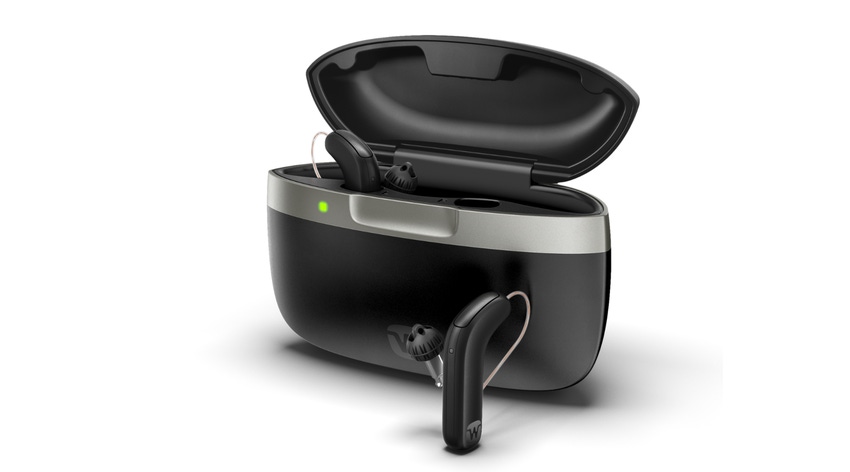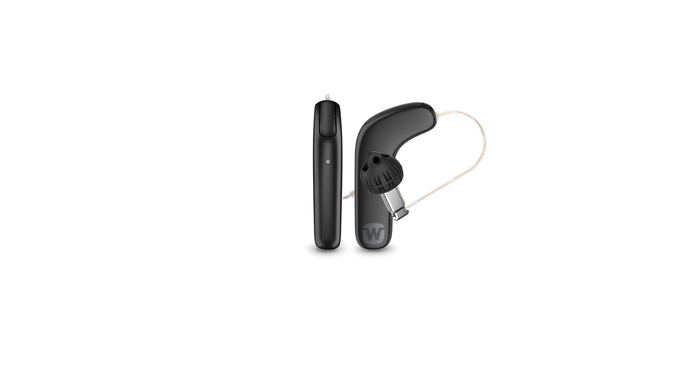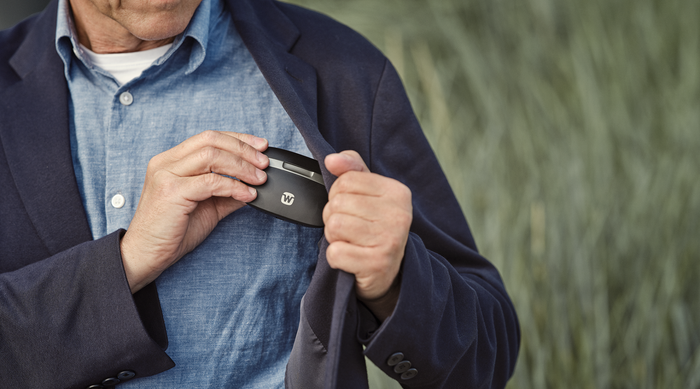Behind the Design: Form Follows Function in New L-Shaped Widex Hearing Aid
A Widex product designer shares insights behind the design of the company's newest hearing aid.
April 11, 2024

At a Glance
- The L-shaped device sits higher on the ear, improving microphone angles for better signal-to-noise ratio.
- The compact charging case provides a full charge in four hours or a partial charge in 30 minutes.
Widex – the developer of the hearing aids that were music to my husband’s ears three years ago – seems to have outdone itself in terms of innovative hearing aid design.
The company recently launched the Widex SmartRIC, an L-shaped hearing aid designed to improve microphone angles to enhance hearing across listening environments.
By placing the SmartRIC higher up on the ear, the angle between the device’s two microphones becomes closer to horizontal. This enables the directional microphone to align with what wearers are focusing on, the idea being that it will improve the user’s signal-to-noise ratio, regardless of their environment.
In addition to the L-shaped angle, Widex has made several other design enhancements to craft an elegant and seamless device that lets wearers enjoy the freedom of not having to think about their hearing aids when they are on the go.
MD+DI connected with Martyn Beedham, an industrial designer for WSAudiology, Widex’ parent company, to glean product design insights from the Widex SmartRIC project.
What’s up with the L-shape design of the new hearing aid?
“In a way, it’s very simple. It's the old adage of form follows function,” Beedham said. “So, obviously, we want to deliver better hearing, we want people to have a device that is comfortable to sit behind the ear easily even if you're wearing glasses, we want something that's easy to use, and of course we want something to be appealing as well because as you can imagine – and maybe you know from your own experience – people are still not thrilled about having a hearing aid.”
So, the task was to design a Widex hearing aid that functioned well enough to improve the user’s ability to hear and communicate, but also to make wearing hearing aids easier.

Image courtesy of Widex
“Every rechargeable hearing aid has a battery inside and this is no different. But what's different here is how we've arranged those components,” Beedham said. “And we've arranged that so that it is specifically performing better, it's also slimmer behind the ear, that means it's more comfortable, it's also discreet behind the ear. So, we're really trying to tick all those boxes and hit all those notes where we can get everything as good as we possibly can.”
The Widex SmartRIC is the company’s best performing and slimmest hearing aid today.
"I'm designing things nobody wants."
There's a lot of stigma attached to needing a hearing aid, and Beedham said Widex wants to destroy that stigma through product design. For many people when they think of a hearing aid, they picture something akin to a "big beige banana," he said.
"When I first started this job I always said, 'I'm designing things that nobody wants.' And that always felt like an odd position because as a designer, you want to be designing the cool stuff. But for me, this is the cool stuff."
Dare to take design risks
In any great design project, there are always things that don't go as expected, presenting challenges that must be overcome. In this case, Beedham said the key challenge was overcoming fear of risk.
“When you do something different, of course there is going to be a bit of fear ... you could say, ‘we’re just always going to play it safe and we’re never going to do anything differently’ so, I do think to a certain extent there were some concerns. Of course, people are rightly concerned that if you step outside the norm and do something outside the box there are concerns,” Beedham said.
The teams involved with the project – from designers like Beedham to audiology electronics engineers and project managers – overcame that fear of risk by following a robust design process.
“We have this good process in place, and we brought everybody along in the process,” he said. “Because it’s so new and it’s so different it always takes a bit more time. And in any business, time is money, and that money is an investment into what we want to do for the future.”
The team conducted thorough design research by hitting the pavement, so to speak, and talking to customers and doing human factors studies to inform the design of the new product.

Image courtesy of Widex
“And I think it’s really paid off with an absolutely unique product,” Beedham said. “... What's interesting for me is that looking at this project there are already now more people coming and saying, ‘We want to do more, we want to go further, let's do that again.’ So, I think doing things right and doing it in a robust way, doing it with the right people behind it ... success breeds success.
The power of portability, with a ‘bit of magic’
As with the Widex Moment hearing aid, the Widex SmartRIC comes with a charger. What’s different about the new model, however, is that this time the charger itself is a portable, compact, battery-powered case. That means users can recharge their hearing aids even when they’re not connected to a power supply. This would have come in handy earlier this week when one of my husband’s hearing aids hadn’t charged properly overnight and died shortly after he arrived at work.

Image courtesy of Widex
So, not only is the SmartRIC the company’s longest-lasting rechargeable receiver-in-canal (RIC) hearing aid, providing up to 37 hours on a single charge, but the hearing aid case is designed to fully charge the hearing aids in four hours. If the user can’t wait that long, a 30-minute fast charge will buy them up to eight hours of continuous use. What’s more, the case offers five full charges before it needs to be connected to a power source, offering the hearing aid user more than a week of off-the-grid hearing.
“That obviously gives you a lot of freedom, a lot of peace mind, you can go away for a weekend or longer depending on how long you use your hearing aids without that worry of not being able to recharge,” Beedham said. “We put a lot of effort into our chargers because the charger is a highly important part of the whole ecosystem.”
He said the team integrated the LED display into a hidden panel so the LEDs are hidden behind a metallic strip.
“When you open the charger, it lights up and the LEDs come on and it's a bit of magic,” Beedham said. “...It feels more sophisticated, it’s also more discreet than having something with flashing lights all over it. We put the same care and attention into the accessories that we do into the hearing aid.”
Music to a designer's ears
While the Widex hearing aids, especially the Widex SmartRIC, are designed with discretion in mind, these modern hearing aids are so different from the hearing aids of the past that a lot of users are actually proud to show them off.
During the usability studies some people commented that they would take their Widex SmartRIC hearing aid off to show people how cool it is. And that, Beedham said, is music to his ears.
About the Author(s)
You May Also Like




